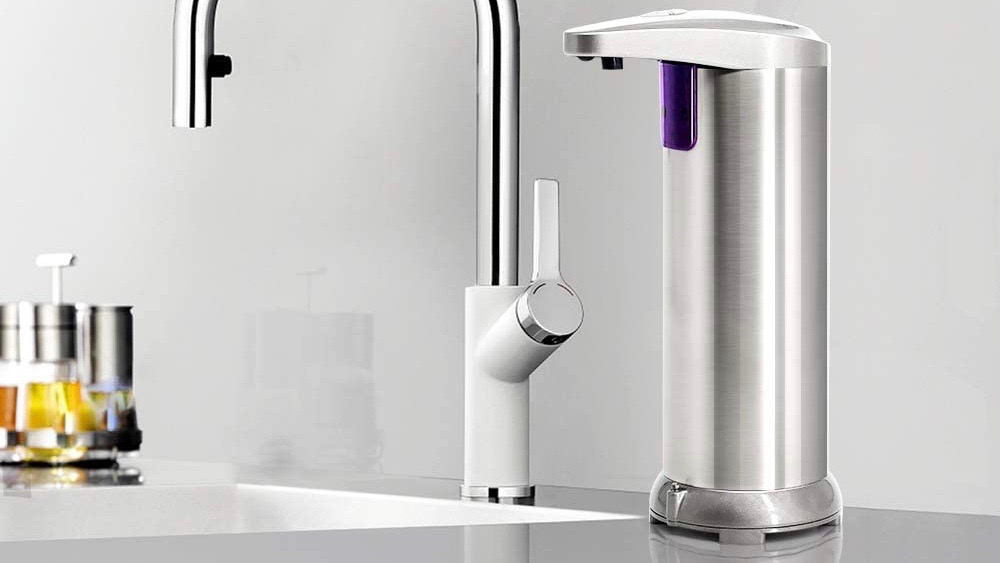Life during the coronavirus can certainly be stressful. Many of us are still stuck at home, separated from familiar social routines. Some are returning to workplaces in states where case counts are rapidly rising. The anxieties can seem endless, but several companies are stepping up to the plate to take on our woes — creating new and amazing products designed to make our lives better (and safer) during the pandemic.
Please be aware that due to COVID-19, product availability is always changing. Some of the items on this list may be on back-order.
iHealth No-Touch Forehead Thermometer

If someone in your family has the virus, it’s a good idea to keep your distance from them as much as possible. But for those times when you need to step in to help someone take their temperature, particularly children, it’s good to have tech like iHealth’s No-Touch thermometer. The device uses a hybrid of three different thermal readings to indicate a person’s body temperature. Just aim the thermometer about an inch from a person’s forehead, then press the measurement button. When the reading is complete, the probe quietly vibrates (which is great for sleeping children), and the temperature reading is displayed on the probe’s LED screen. The No-Touch is powered by two AAA batteries, along with instructions and a one-year warranty.
TROPRO Touchless Soap Dispenser
Combining touch-free tech and sleek design, this soap pump by TROPRO is great for both the home and office. The pumping technology reacts to how closely your hand is placed to the dispenser. Hold it close for a little soap, or farther away for more. The simple two-button design handles both power and soap (or hand sanitizer) volume. Long-press to turn the dispenser on/off; when turned on, use short presses to adjust output. The leak-free casing means you won’t have to worry about shorting out the device and it will run on any brand of AAA batteries. Our only small criticism is that we wish the dispenser ran on its own rechargeable power.
Forno Anti-Touch Door Opener Tool

It may not look like much, but this keychain-sized door opener can open several different types of door or drawer handles and knobs, and can be conveniently used for several other purposes. Press elevator buttons, grip and flush toilet handles, and interact with and power on/off certain devices. The gizmo is made of solid brass, so it won’t smash or crack if you accidentally drop it, and can be easily cleaned and sanitized with your preferred disinfectant. Even after the virus passes, it’ll be nice to have this little guy around. It’s also sweet that for under $20, you get four of them.
59s UV Light Sanitizer Wand

This portable disinfectant-wand is great for on-the-go sanitizing, thanks to a series of ultra-powerful UV-C LED lights. Use it to disinfect your phone and other mobile tech, sofas, beds, and many other surfaces. To use, just unfold and scan the wand back-and-forth over the surface you’re trying to disinfect. Shoot for five to 10 swipes at about an inch away. That’s all there is to it. After about three minutes, the wand will power down (or you can press the scan button to manually end the cycle). The auto shut-off function will engage if the wand is accidentally turned over or re-folded during disinfection, and thanks to the built-in rechargeable battery, you won’t have to worry about power when you’re traveling.
GoZone Wi-Fi Touchless Menu™

Right now, it’s crucial for re-opening businesses to minimize or eliminate touch-heavy items like physical menus. Fortunately, there’s a product designed for just that purpose. From the folks at GoZone Wi-Fi (a network analytics firm), Touchless Menu is a combination of hardware and software for both restaurant owners and their returning guests. How it all works is quite simple, but extremely effective: GoZone provides restaurant owners with a pre-configured Wi-Fi router that connects to their existing network-gear. After restaurant owners upload their menu to GoZone’s servers, the GoZone router creates its own Wi-Fi network that guests can connect to with their mobile devices. When guests launch their web browsers, the menu will automatically be displayed on their device. Demos of the product suite (as well as add-ons for other GoZone services) are available over on GoZone’s site.
Fitbit Ready for Work Dashboard

It can be tough to decide whether or not you should return to work, especially if your state is in the middle of a virus peak. Fortunately, the minds at Fitbit have designed a new application for employers and their workforces. Once the service is purchased and activated, employees can download the Ready for Work app on their mobile device. Each day, the app walks the employee through a check-list of symptoms, and also allows them to input temperature and heart-rate readings, as well as symptom tracking. Many of these readings are synced to the app from actual Fitbit devices, whether employer-provided or personally owned. Based on the employee’s data, the app will then offer guidance on whether or not the employee should go into work that day. The app also offers various wellness services, such as positivity coaching and mobile co-op games for estranged office buddies.
For business owners, the Ready for Work dashboard lets the employer know whether or not employees are willing to return to work, as well as monitor to see if there is any history of COVID-19 symptoms on their team.




